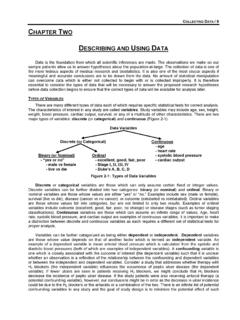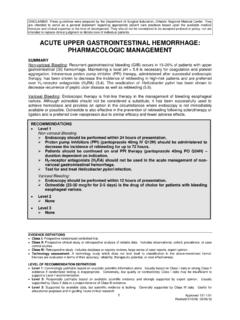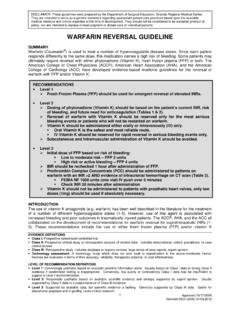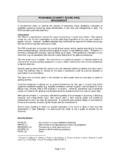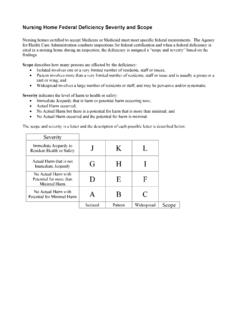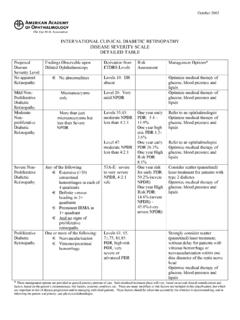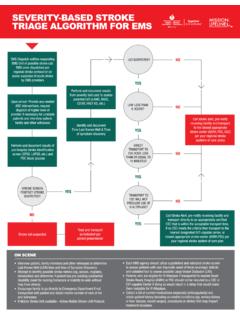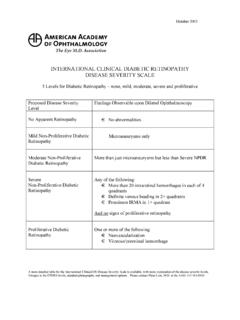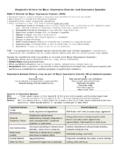Transcription of INJURY SEVERITY SCORING - SurgicalCriticalCare.net
1 INJURY SEVERITY SCORING INJURY SEVERITY SCORING is a process by which complex and variable patient data is reduced to a single number. This value is intended to accurately represent the patient's degree of critical illness. In truth, achieving this degree of accuracy is unrealistic and information is always lost in the process of such SCORING . As a result, despite a myriad of SCORING systems having been proposed, all such scores have both advantages and disadvantages. Part of the reason for such inaccuracy is the inherent anatomic and physiologic differences that exist between patients. As a result, in order to accurately estimate patient outcome, we need to be able to accurately quantify the patient's anatomic INJURY , physiologic INJURY , and any pre-existing medical problems which negatively impact on the patient's physiologic reserve and ability to respond to the stress of the injuries sustained.
2 Outcome = Anatomic INJURY + Physiologic INJURY + Patient Reserve GLASGOW COMA SCORE The Glasgow Coma Score (GCS) is scored between 3 and 15, 3 being the worst, and 15 the best. It is composed of three parameters : Best Eye Response, Best Verbal Response, Best Motor Response, as given below: Best Eye Response (4) 1. No eye opening 2. Eye opening to pain 3. Eye opening to verbal command 4. Eyes open spontaneously Best Verbal Response (5) 1. No verbal response 2. Incomprehensible sounds 3. Inappropriate words 4. Confused 5. Orientated Best Motor Response (6) 1. No motor response 2. Extension to pain 3. Flexion to pain 4. Withdrawal from pain 5. Localising pain 6. Obeys CommandsNote that the phrase 'GCS of 11' is essentially meaningless, and it is important to break the figure down into its components, such as E3 V3 M5 = GCS 11.
3 A Coma Score of 13 or higher correlates with a mild brain INJURY , 9 to 12 is a moderate INJURY and 8 or less a severe brain INJURY . Teasdale G., Jennett B., Lancet 1974; 81-83. GLASGOW PEDIATRIC COMA SCORE The Pediatric GCS is scored between 3 and 15, 3 being the worst, and 15 the best. It is composed of three parameters : Best Eye Response, Best Verbal Response, Best Motor Response, as given below: Best Eye Response (4) 1. No eye opening 2. Eye opening to pain 3. Eye opening to verbal command 4. Eyes open spontaneously Best Verbal Response (5) 1. No vocal response 2. Inconsolable, agitated 3. Inconsistently consolable, moaning 4. Cries but is consolable, inappropriate interactions 5. Smiles, oriented to sounds, follows objects, interacts Best Motor Response (6) 1. No motor response 2. Extension to pain 3. Flexion to pain 4. Withdrawal from pain 5.
4 Localising pain 6. Obeys Commands 1 Revised 5/29/01 ORGAN GRADING SCALES The Organ INJURY Scales were developed by the Organ INJURY Scaling Committee of the American Association for the Surgery of Trauma (AAST). Originally convened in 1987, these SCORING systems are modified and updated as deemed appropriate by the Committee. These scales provide a common nomenclature by which physicians may describe injuries sustained and their SEVERITY . Each organ INJURY may be graded from 1 to 6. A 1 is assigned to the least severe INJURY while a 5 is assigned to the most severe INJURY from which the patient may survive. Grade 6 injuries are, by definition, not salvageable and severe enough to claim the patient s life.
5 Injuries may also be divided by mechanism ( blunt vs. penetrating ) or by anatomic description ( hematoma , laceration , contusion , vascular ). Accompanying each INJURY grade in Appendix 1 is the respective International Classification of Disease- 9th Edition (ICD-9) code and the Abbreviated INJURY Scale (AIS) code. For some of the injuries listed, the ICD-9 code has been revised from that listed in the original AAST scales to more appropriately describe the INJURY . Moore EE, Shackford SR, Pachter HL, et al: Organ INJURY scaling - spleen, liver and kidney. J Trauma 29:1664, 1989. Moore EE, Cogbill TH, Malangoni MA, et al: Organ INJURY scaling II: pancreas, duodenum, small bowel, colon and rectum. J Trauma 30:1427, 1990 Moore EE, Cognill TH, Jurkovich GJ, et al: Organ INJURY scaling III: chest wall, abdominal vascular, ureter, bladder and urethra. J Trauma 33:337,1992 Moore EE, Malangoni MA, Cogbill TH, et al: Organ INJURY scaling IV: thoracic vascular, lung, cardiac and diaphragm.
6 J Trauma 36:229, 1994 Moore EE, Cogbill TH, Jurkovich MD, et al: Organ INJURY scaling: spleen and liver (1994 revision). J Trauma 38:323, 1995 ABBREVIATED INJURY SCALE The Abbreviated INJURY Scale (AIS) is an anatomical SCORING system first introduced in 1969. Since this time it has been revised and updated against survival so that it now provides a reasonably accurate ranking of the SEVERITY of INJURY . The latest incarnation of the AIS score is the 1998 revision. The AIS is monitored by a scaling committee of the Association for the Advancement of Automotive Medicine. Injuries are ranked on a scale of 1 to 6, with 1 being minor, 5 severe, and 6 a nonsurvivable INJURY . This represents the 'threat to life' associated with an INJURY and is not meant to represent a comprehensive measure of SEVERITY . The AIS is not an INJURY scale, in that the difference between AIS1 and AIS2 is not the same as that between AIS4 and AIS5.
7 There are many similarities between the AIS scale and the Organ INJURY Scales of the AAST. INJURY AIS Score 1 Minor 2 Moderate 3 Serious 4 Severe 5 Critical 6 Unsurvivable Copes WS, Sacco WJ, Champion HR, Bain LW, "Progress in Characterising Anatomic INJURY ".
8 In Proceedings of the 33rd Annual Meeting of the Association for the Advancement of Automotive Medicine, Baltimore, MA, USA 205-218 2 Revised 5/29/01 INJURY SEVERITY SCORE (ISS) & NEW INJURY SEVERITY SCORE (NISS) The INJURY SEVERITY Score (ISS) is an anatomical SCORING system that provides an overall score for patients with multiple injuries. Each INJURY is assigned an AIS and is allocated to one of six body regions (Head, Face, Chest, Abdomen, Extremities (including Pelvis), External). Only the highest AIS score in each body region is used. The 3 most severely injured body regions have their score squared and added together to produce the ISS score. An example of the ISS calculation is shown below: Region INJURY Description AIS Square Top Three Head & Neck Cerebral Contusion 3 9 Face No INJURY 0 Chest Flail Chest 4 16 Abdomen Minor Contusion of Liver Complex Rupture Spleen 2 5 25 Extremity Fractured femur 3 External No INJURY 0 INJURY SEVERITY Score: 50 The ISS score takes values from 0 to 75.
9 If an INJURY is assigned an AIS of 6 (unsurvivable INJURY ), the ISS score is automatically assigned to 75. The ISS score is virtually the only anatomical SCORING system in use and correlates linearly with mortality, morbidity, hospital stay and other measures of SEVERITY . Its weaknesses are that any error in AIS SCORING increases the ISS error. Many different INJURY patterns can yield the same ISS score and injuries to different body regions are not weighted. Also, as a full description of patient injuries is not known prior to full investigation & operation, the ISS (along with other anatomical SCORING systems) is not useful as a triage tool. As multiple injuries within the same body region are only assigned a single score, a proposed modification of the ISS, the "New INJURY SEVERITY Score" (NISS), has been proposed. This is calculated as the sum of the squares of the top three scores regardless of body region.
10 The NISS has been found to statistically outperform the traditional ISS score. Baker SP et al, "The INJURY SEVERITY Score: a method for describing patients with multiple injuries and evaluating emergency care", J Trauma 14:187-196;1974 INTERNATIONAL CLASSIFICATION OF DISEASES INJURY SEVERITY SCORE (ICISS) ICISS utilizes the ICD-9 codes assigned to each patient to calculate a SEVERITY of INJURY score. Measured survival risk ratios are assigned to all ICD-9 trauma codes. The simple product of all such ratios for an individual patient's injuries have been found to predict outcome more accurately than ISS. ICISS = (SRR)injury1 x (SRR)injury2 x (SRR)injury3 X (SRR) ICISS is promoted as being able to be calculated from existing hospital information without the need for a dedicated trauma registrar. This assumes, however, that the non-clinical hospital coders are able to accurately interpret and document the injuries sustained.


